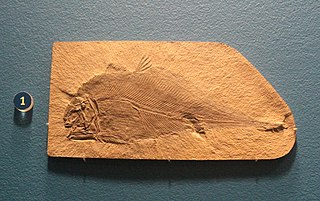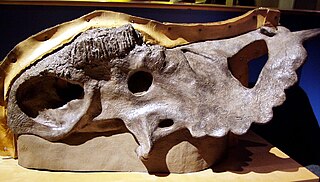| Wiota Gravels | |
|---|---|
| Stratigraphic range: Pleistocene | |
| Type | Formation |
| Overlies | the Bearpaw Formation, the Hell Creek Formation, the Fox Hills Formation, and the Fort Union Formation |
| Location | |
| Coordinates | 48.089744622861474,-106.46547674907227 |
| Region | Montana |
| Country | United States |
| Type section | |
| Named for | Wiota Station |
The Wiota Gravels is a geologic formation in Montana. It preserves fossils dating to the Pleistocene .

Wiota is a town in Lafayette County, Wisconsin, United States. The population was 856 at the 2010 census. The unincorporated communities of Wiota, Woodford and Five Corners are located in the town.

Avisaurus is a genus of enantiornithine bird from the Late Cretaceous of North America.
Diclonius is a genus of dinosaur from the Late Cretaceous. It was a hadrosaur based solely on teeth. Its fossils were found in the Judith River Formation of Montana, northern US. The name is in reference to the method of tooth replacement, in which newly erupting replacement teeth could be in functional use at the same time as older, more worn teeth. Thus, the number of "sprouting" teeth was doubled in comparison to Monoclonius, which used only one set of teeth at a time and which Cope named in the same paper.

The Cloverly Formation is a geological formation of Early and Late Cretaceous age that is present in parts of Montana, Wyoming, Colorado and Utah in the western United States. It was named for a post office on the eastern side of the Bighorn Basin in Wyoming by N.H. Darton in 1904. The sedimentary rocks of formation were deposited in floodplain environments and contain vertebrate fossils, including a diverse assemblage of dinosaur remains. In 1973, the Cloverly Formation Site was designated as a National Natural Landmark by the National Park Service.

The Bearpaw Formation, also called the Bearpaw Shale, is a geologic formation of Late Cretaceous (Campanian) age. It outcrops in the U.S. state of Montana, as well as the Canadian provinces of Alberta and Saskatchewan, and was named for the Bear Paw Mountains in Montana. It includes a wide range of marine fossils, as well as the remains of a few dinosaurs. It is known for its fossil ammonites, some of which are mined in Alberta to produce the organic gemstone ammolite.

Allenypterus is a genus of a prehistoric lobe-finned fish which lived during the Bashkirian stage of the Late Carboniferous period, 318 million years ago). Fossils have been discovered in Bear Gulch Limestone, Montana, USA.
The Eagle Sandstone, originally the Eagle Formation, is a geological formation in Montana whose strata date back to the Late Cretaceous. It is a light to brownish gray to pale yellow-orange, fine-grained sandstone. It contains areas of crossbedding and local shale members. It contains large sandy calcareous concretions. Its thickness varies from 100 to 350 feet due to the lens nature of the individual sandstone layers and local interbedded sandy shale layers.
Fort Hamilton was a frontier fort constructed in present-day Wiota, Wisconsin during the 1832 Black Hawk War.
Paralbula is an extinct genus of prehistoric bony fish. They can be found in the Hell Creek Formation, in Montana, United States.

Pachyrhinosaurini is a tribe of centrosaurine dinosaurs. The clade existed during the Late Cretaceous, about 84.9 to 68.5 million years ago, evolving during the earliest Campanian, and becoming extinct in the Maastrichtian. The tribe contains three genera: Einiosaurus, Achelousaurus, and Pachyrhinosaurus. Pachyrhinosaurus and Achelousaurus form the clade of pachyrhinosaurins called the Pachyrostra ("thick-snouts"), characterized primarily by their nasal bosses.

Wiota is an unincorporated community and census-designated place (CDP) in the town of Wiota, Lafayette County, Wisconsin, United States. Wiota is located on Wisconsin Highway 78 6.2 miles (10.0 km) southwest of Argyle. Its population was estimated to be 97 in 2017.
The Amsden Formation is a geologic formation in Montana. It preserves fossils dating back to the Carboniferous period.
The Three Forks Shale is a geologic formation in Montana and North Dakota. It preserves fossils dating back to the Devonian period.
The Tullock Formation is a geologic formation in Montana. It preserves fossils dating back to the Paleogene period.

The Park City Formation is a geologic formation in Montana and Utah. It preserves fossils dating back to the Permian period.

The Dinwoody Formation is a geologic formation in Montana. It preserves fossils dating back to the Triassic period.

The Thaynes Formation is a geologic formation in Montana and Idaho. It preserves fossils dating back to the Triassic period, such as Ammonoidea, Actinopterygii, Actinistia, Conodonta, Gastropoda, Nautiloidea, Ichthyosauria and others. A diverse fauna known as the Paris Biota has been described from the Thaynes Formation.
The Belle Fourche Formation or Belle Fourche Shale is a fossiliferous early Late-Cretaceous geologic formation classification in Wyoming. Named for outcrops in Belle Fourche River, Wyoming, this unit name is also used in Montana, North Dakota, and South Dakota.
Trierarchuncus is a monotypic genus of alvarezsaurid theropod which includes a single species, Trierarchuncus prairiensis, which is known from fossils found in deposits of the Hell Creek Formation in Montana. It is the youngest known alvarezsaurid and one of the last non-avian dinosaurs, going extinct during the Cretaceous–Paleogene extinction event, which occurred approximately 66 million years ago.